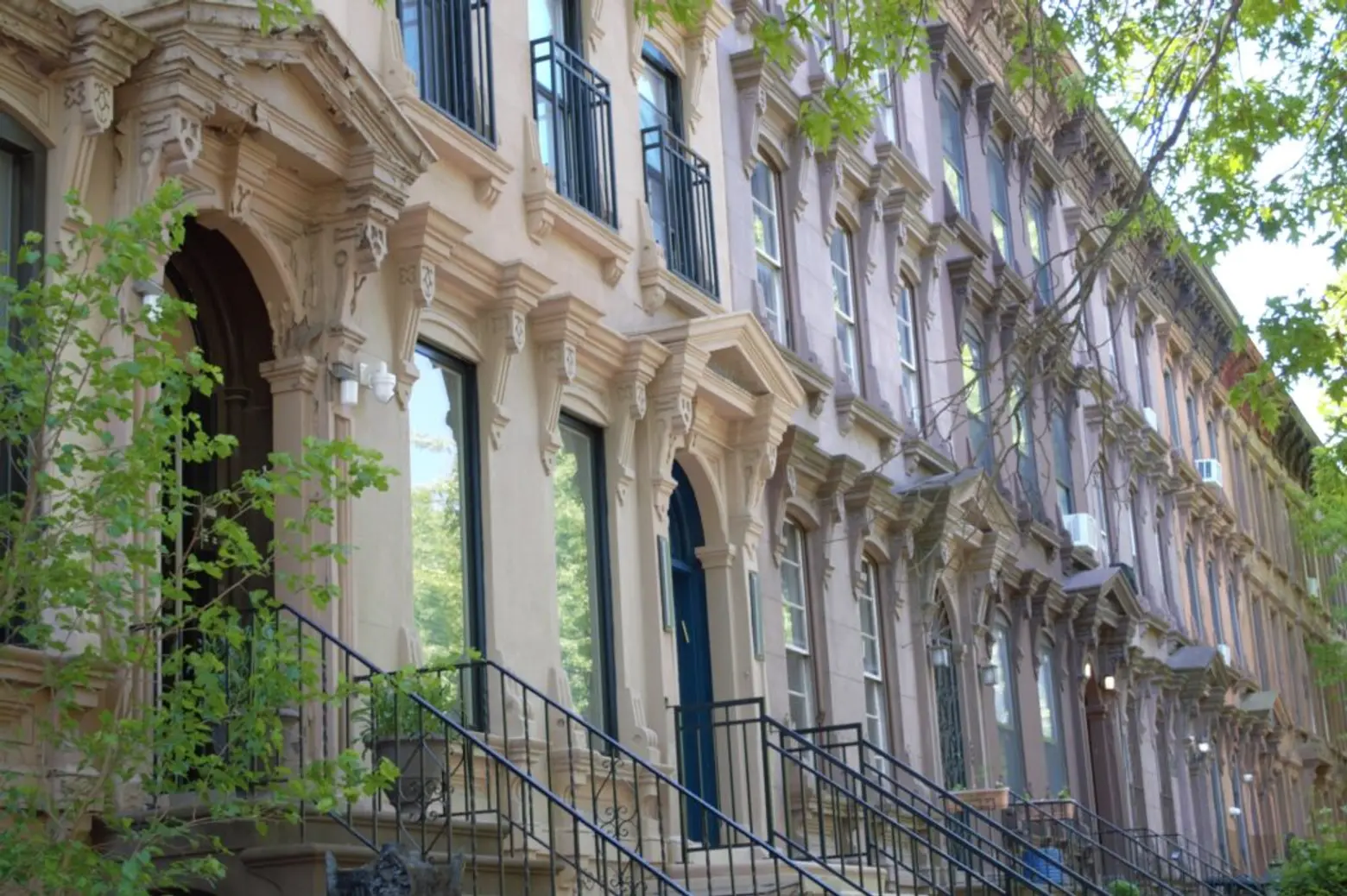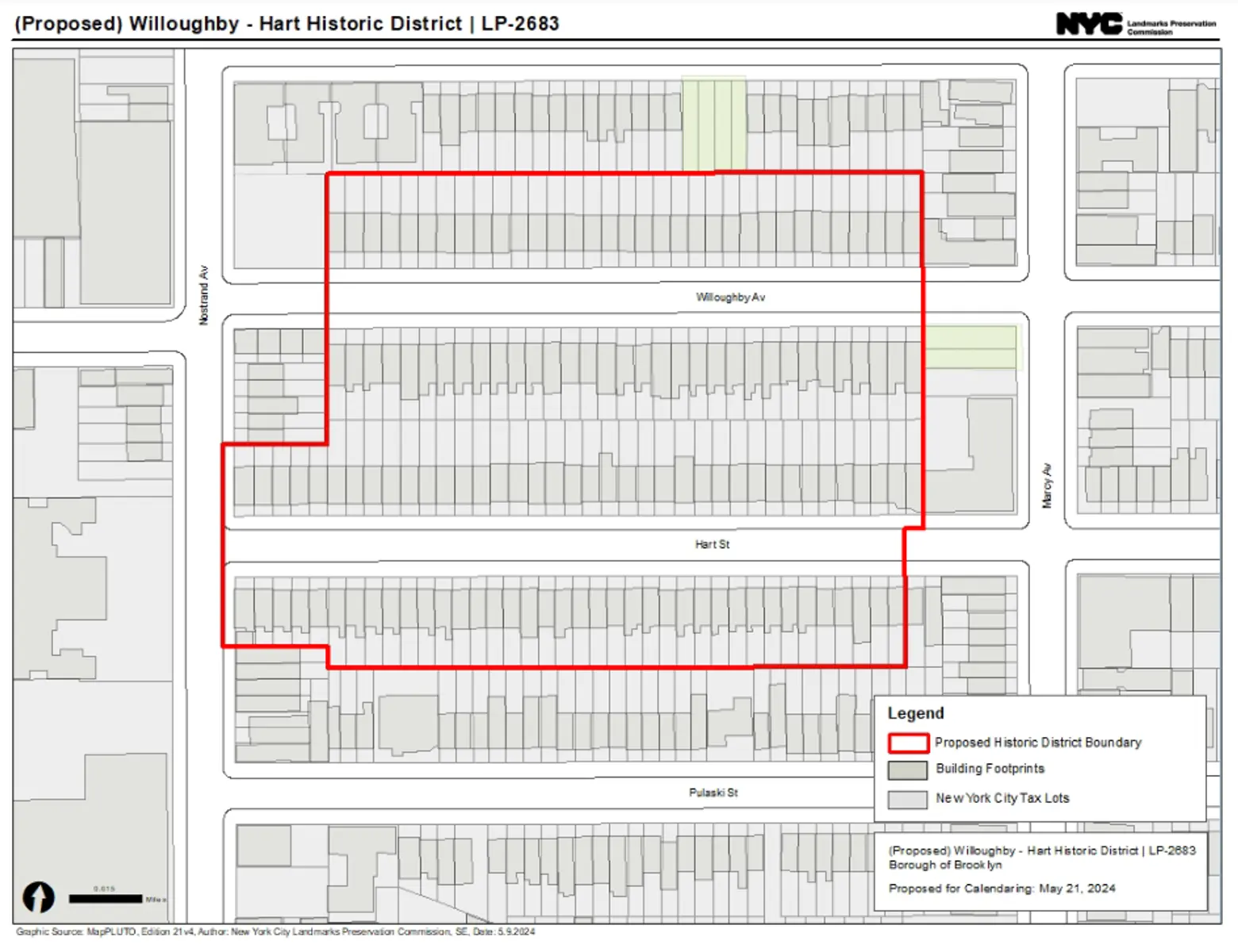Two blocks of brownstones in Bed-Stuy now an NYC historic district


Photos courtesy of the Landmarks Preservation Commission
New York City’s newest historic district is a two-block stretch of homes in Bed-Stuy. The Landmarks Preservation Commission on Tuesday voted to designate the Willoughby-Hart Historic District, which includes two streets of intact 19th-century rowhouses between Marcy and Nostrand Avenues. Built primarily in the Neo-Grec style between the 1870s and 1890s, the 150-year-old homes are architecturally cohesive and reflect a period of Brooklyn’s transformation from farmland to residential, according to the commission.

According to the LPC research staff, the district historically sat within the community known as Cripplebush, developed in the mid-17th century along the historic Cripplebush Road that connected the settlement of Bedford Corners to Newtown in Queens. After more roads were constructed in the early 19th century, the neighborhood grew, and by 1855, the area became known as the Eastern District. That area was later annexed into New York City, jumpstarting development and expansion.
This period of rapid development in this section of Bed-Stuy was further amplified by the expansion of streetcar lines and the completion of the Brooklyn Bridge.
The earliest residents within the proposed district were mostly middle-class German immigrants. By the early 20th century, the area had become home to a large population of Jewish immigrants from Russia. In the 1950s and 60s, Black families moved to the area and Bed-Stuy eventually became the largest Black community in the five boroughs.
A few notable residents of the district include legendary jazz drummer Maz Roach, who lived at 448 Willoughby Avenue for a short period, and Countess Alma Von Blucher, a philanthropist in the German community.

Members of the Advocates for Willoughby Hart group have been pushing for the area’s landmarking since the demolition of the Jacob Dangler House in July 2022. The former historic French Gothic Mansion has stood at the corner of Willoughby and Nostrand Avenues for 120 years and was demolished, despite a campaign to landmark the building led by residents and public officials.
The homes within the proposed historic district predominantly feature the Neo-Grec style, in addition to the Second Empire style, characterized by their intact mansard roofs, the commission noted.
Plus, a few homes on Hart Street exemplify the Romanesque Revival style, with the characteristic rusticated stone facades, and Queen Anne style, seen in “checkerboard patterning, intricate, carved detail, and imposing L-shaped stoops,” as reported by Brownstoner.
Advocates for Willoughby Hart researched the proposed historic district, mobilized neighbors to the cause, hosted community meetings, and gathered over 1,000 signatures on a petition calling on the LPC to landmark the area, according to Brownstoner.
A group of homeowners opposed to the landmarking had concerns over the cost of maintaining and renovating homes within the proposed district. An online petition against the historic district had gathered over 1,750 signatures as of last month.
“We have heard both support and opposition and have taken time for additional conversations with property owners and their representatives. We are aware that some permits for facade work and interior work have been filed and issued at the Department of Buildings, and we will continue to monitor that work and work with property owners,” Sarah Eccles, LPC researcher, said.
Existing historic districts in Bed-Stuy include the Stuyvesant Heights Historic District, the Bedford-Stuyvesant/ Expanded Stuyvesant Heights Historic District, and the Bedford Historic District.
The public hearing on the proposed historic district on June 11 was not without controversy. Members of the neighborhood’s Orthodox Jewish community claimed landmarking the area and restricting development on their properties would be anti-Semitic.
Adam Leitman Bailey, a real estate lawyer, said the designation would discriminately affect the neighborhood’s Orthodox Jews, who often need to add extensions to their homes to accommodate large families:
“Never in the history of the USA has a body voted to remove this many Jews from the streets through passing a vote. The fact is, when they mention community, they want a community without Jews. The other community has been threatened, asked to leave, and trash is constantly brought to their door.”
Bailey continued on, despite being told his allotted time was over, stating that Bed-Stuy’s Jewish community has been left out of community outreach and hasn’t had a say on the area’s designation: “We don’t get information, we don’t get invited to meetings, we were not involved in the process. The Jewish people were not involved in the process of anything to do with this landmarking process.”
While he was unable to attend Tuesday’s vote, Commissioner Michael Goldblum pushed back against the accusations of anti-Semitism in a written statement, which LPC Chair Sarah Carroll read into the record on Tuesday:
“A buyer of a townhouse who wants to enlarge it is subject to zoning, the four main building codes, fire code, energy code, DOT, BEP, and more; each one limits what we can build, each changes over time, shuffling and shifting the rules we all build by. Are all these therefore anti-Semitic?”
“Regrettably, anti-Semitism is real. Jewish people get abused, harassed, hurt, or even killed for being Jewish, now more than in over 30 years. But, as an observing Jew with personal familiarity with the pain that anti-Semitism can cause, I would say that anyone, especially a Jew, who uses the accusation of anti-Semitism or racism cynically or otherwise, to influence a land use process like this, is doing all Jews and all minorities a disservice because to misuse the claim is to diminish its power.”
Commissioner Jeanne Lutfy agreed with Goldblum’s statement and said designation does not prevent owners from updating their properties.
“Landmarking is not–and doesn’t have to be–restrictive,” Lutfy said ahead of Tuesday’s vote. “What it does is it offers homeowners and the community at large a framework that enables them to preserve not only the integrity of their homes but the integrity of their community, the history of the neighborhoods they live in, and the culture surrounding it, which includes the whole borough and the city as a whole.”
Chair Carroll said the commission hosted three public owner meetings and more than 20 meetings with individual owners. “The commission works closely with owners to help them make changes that meet their needs while preserving the significant architectural features of the building,” Carroll said. “The commission routinely approves rooftop and rear yard expansions, both at staff level and commission level.”
LPC voted to designate the Willoughby-Hart Historic District unanimously with eight commissioners in favor and none opposed.
Editor’s note: The original version of this article was published on May 22, 2024, and has since been updated to include the LPC’s vote on June 25 and additional info.
RELATED:





